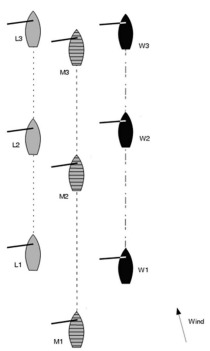|
Rule 11 required W to keep clear of L throughout the incident. While M was
clear astern of L, rule 12 required her to keep clear of L, and after she became
overlapped with L rule 11 required her to keep clear of L. As the diagram
shows, both M and W met these requirements.
Because both W and M were required to keep clear of L throughout the
incident, L was an obstruction to W and M during that time (see the last
sentence of the definition Obstruction). However, because L was a boat under
way, L was not a continuing obstruction to them (see the definition Continuing
Obstruction). When M became overlapped with W, rule 19.2(b) began to apply
between them. It required W to give M room between her and the obstruction,
unless she was unable to do so from the time the overlap began. As the facts
clearly show, W was able to give M that room when the overlap began and
continued to do so at all times until the boats finished. Therefore, W complied
with rule 19.2(b). Rule 19.2(c) did not apply because the obstruction, L, was not
a continuing obstruction. M broke no rule; therefore, W's appeal is dismissed.
|
